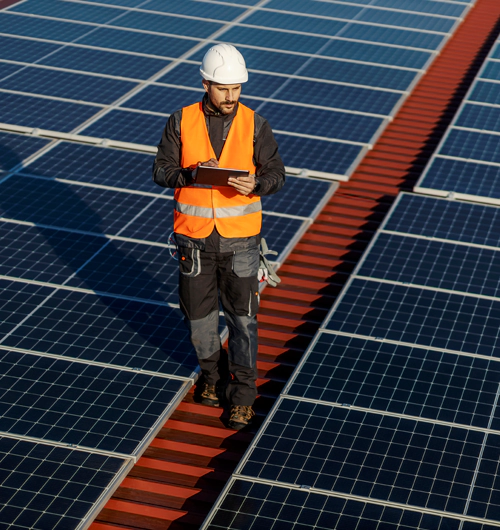Basic Solar Terms
Surya Urza is a fully integrated solar solutions provider from wafer to cell, module, subsystems, systems, installation, commissioning, maintenance and service.
Albedo – The ratio of light reflected from a surface.
Alternating current (AC) – In Fact, an electric current that reverses in direction at regular intervals.
Altitude – Therefore, height of sun above the horizon.
Ampere (amp) – Likewise, A certain number of electrons passing a fixed point each second corresponds to one ampere and which is a unit of electric that refers to the flow of current.
Array – Thus, photovoltaic modules connected together to provide a single electrical output.
Azimuth – Similarly, One measures horizontal angles clockwise in degrees from a reference direction, and typically the north or south point of it , to the intersection point of the object’s line of altitude on these.
Cell – basic unit of a photovoltaic panel. Diffuse insolation – Atmospheric components or such as clouds and dust, scatter or reflect solar radiance.
Direct current (DC) – an electric current in which the electrons flow in one direction only.
Direct insolation – solar radiance that directly hits the earth’s surface.
Electrical efficiency – useful power output divided by the total electrical power consumed.
Circuit – complete path of an electric current, including the generating apparatus, intervening resistors, or capacitors.
Energy flow system – rate of flow of electric charge, measured in amperes.
Power grid – interconnected network for distributing electricity.
Current Loop – any source of usable power, as fossil fuel, electricity, or solar radiation.
Gigawatt (GW) – 1,000,000,000 watts.
Insolation – measure of solar radiation energy received on a given surface area in a given time.
Inverter – device that converts DC electricity into AC electricity.
Junction box – protected enclosure for electrical wiring.
Megavolt (kW) – 1,000 watts.
Kilowatt-hour (kWh) – measure of kilowatt production of power in kilowatts and time in hours.
TERMS Load (noun) – (1) the power consumed on an electrical circuit. (2) a power-absorbing device, such as a blender, light bulb, etc.
Strain (verb) – to add a power-absorbing device to an electrical circuit .
Megawatt (MW) – 1,000,000 watts.
Module – interconnected assembly of solar cells; also called a panel.
Monocrystalline – Monocrystalline panels, which are rated as the most efficient solar technology, are made from a single, large silicon crystal.
Ohm – unit of electrical resistance.
Photovoltaic (PV) – The application of solar cells for energy by converting radiant energy directly to electricity is related to technology and research.
Solar voltaic technology efficiency – Thus, efficiency rate of a solar cell is the ratio of power produced by cell at any given moment to the power of the radiant energy that strikes it. Factors such as temperature can cause variation in the efficiency rate throughout the day.
Photovoltaic system – A solar energy system uses solar cells to convert light into electricity. It comprises several components, including solar cells, mechanical and electrical connections, mountings, and means for regulating and/or modifying the electrical output.
Polycrystalline cell – solar cells produced from processed liquid silicon; when solidified, multiple silicon crystals are formed. Less efficient than monocrystalline cell in Basic Solar Terms.
Radiance – light from the sun; also called solar radiance.
Remote system – photovoltaic system not connected to the utility grid.
Silicon – a chemical element from which semiconductors are made.
Solar – (1) panel of or pertaining to the sun.
(2) Utilizing, operated by, or depending on solar energy.
(3) Manufacturing or providing solar power.
Solar constant – the average density of solar radiation measured outside Earth’s atmosphere and at Earth’s mean distance from the sun, equal to 0.140 watt per square centimeter.
Basic terms of suryaurza Solar energy – energy derived from the sun in the form of solar radiation.
Solar power – energy from the sun that is converted into thermal or electrical energy.
Solar spectrum – distribution of energy emitted by the sun arranged in order of wavelengths.
Solar thermal – method of harnessing solar energy for thermal energy (heat).
Thin film – Manufacturers directly deposit a thin layer of semiconductor material, such as amorphous silicon, onto a plate of glass to create solar cells. This method produces the least efficient type of solar cells.
Tracking array – a solar array that follows the path of the sun to maximize the solar radiation incident on the photovoltaic surface.
Transformer – a device used to transfer electrical energy from one circuit to another with an alternating current and a transformer will either raise or lower the voltage as it makes the transfer.
Volt (V) – standard unit of voltage is one volt produces one ampere of current when acting a resistance of one ohm.
Voltage – Morever, potential energy that makes the electrical current flow in a circuit by pushing the electrons around (pressure).
Watt (W) – Thus, unit of electric power, or amount of work (J) and done in a unit of time. One ampere of current flowing at a potential of one volt produces one watt of power.




